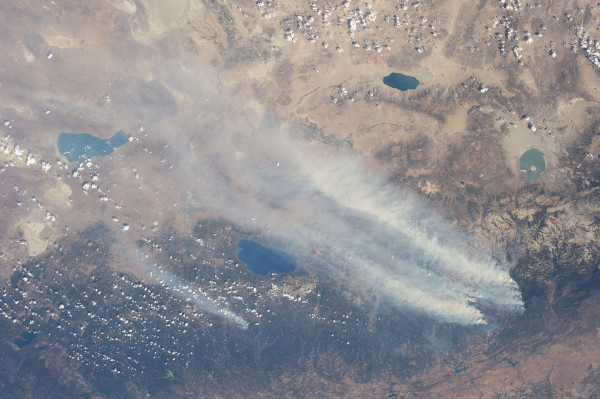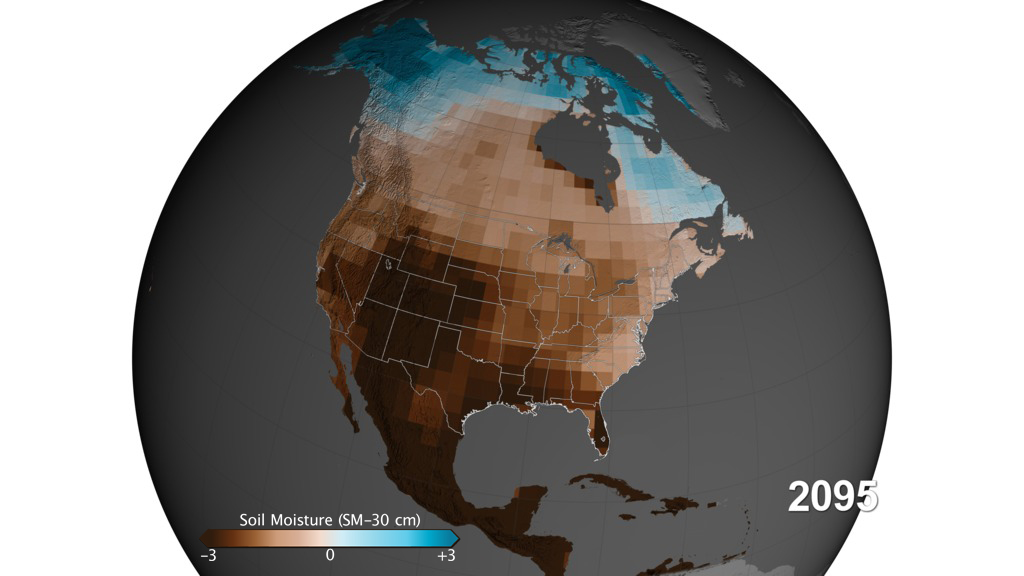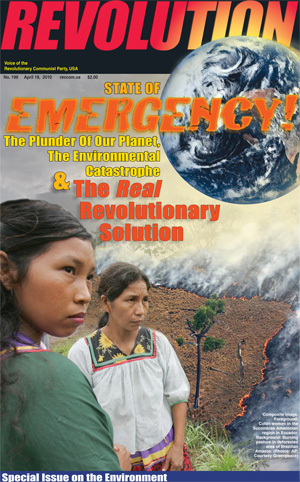California Drought: Natural Causes and an Insane System
April 27, 2015 | Revolution Newspaper | revcom.us
California is being gripped by the most severe drought in its recorded history, possibly the worst it has experienced in 1,200 years. After four years, 80 percent of the state is now experiencing “extreme drought.”
The drought in California is the latest concentration point of an overall drought in the Southwest that has also stretched in recent years into Mexico. In 2010-2013 especially, Mexico faced drastic impacts on agriculture and ruination of people’s lives from drought, even worse than normal. U.S. officials and the media have chauvinistically acted as if drought stops at the U.S. border.
This is a natural crisis, brought on in its immediate sense by changes in weather patterns, bringing a drastic lack of precipitation. But this is also a crisis amplified by record high temperatures causing evaporation and drying of soil, connected to human-caused global warming. (See box on “The Drought’s Causes and Future in a Warming World.”) More deeply, this is an unnatural crisis that is rooted in and intensified by relentless capitalist economic development and growth over decades that has had no regard for the limits of natural resources, (water in this case) and the dependence of humans and nature on water. This growth has also taken place with no appreciation of, or even attempt to take into account, the long term climate history of California or the Southwest and what this would really mean for a society and economy built in this region.
For years this crisis has been looming and the state has done little to address it. But now things are cracking open. Millions of people and natural ecosystems are being impacted. The effects of the drought will be widespread and long-lasting.
This year the drought has intensified, with more of the state entering more extreme drought. Even more troubling—the snowpack in the Sierra Nevada mountains this year, which large sections of the state rely on for a release of melting water into reservoirs, rivers and aqueducts in the late spring and summer months—is only 6 percent of normal. So this summer the situation will very likely worsen. Last year the Association of California Water Agencies said that another year of drought would cause “disastrous consequences”. According to Jay Famiglietti, a water scientist for NASA and professor at University of California, Irvine, the three main water sources for California—snowmelt from the Sierra Nevada, local groundwater, and imported water from the Colorado river—are all declining.
In April, California governor Jerry Brown instituted mandatory water restrictions aimed at cutting water usage for residential users by 25 percent. These measures are tiered so that communities that have already cut water usage aren’t required to cut as drastically as others. Across the state there is a crazy and complex patchwork—where certain cities and peoples have been innovatively seeking to conserve water in all kinds of ways, while many other areas continue to mindlessly use water in frivolous ways—watering golf courses and lawns in the middle of the desert, etc. Some of this will be curtailed with the restrictions. But so far at least, these restrictions don’t even address the heart of the matter. 80 percent of water in California goes to agriculture and much of this water use comes from completely unsustainable gobbling up of groundwater reserves. While agriculture is only 2 percent of the economy in California, it has been built up to be a keystone of food production for the U.S. and exports worldwide. California produces 50 percent of the country’s nuts, fruits and vegetables. Farmers have been driven to plant large areas with almond trees to try to cash in on the high price of almonds on the world market. But these trees require large amounts of water and are vulnerable because, once planted, they need to be watered just to keep them alive. And increasingly there is a drastic lack of water. State regulations cannot deal rationally with transforming these kinds of contradictions—which lie deep in the anarchic workings of the capitalist system. Decisions are made based on short-term profitability—not on the needs of the masses of people, the health of the environment, or on the actual limits of availability of water and long-term climate trends.
Water Wars, Expansion, and Unsustainable Use of Water
Over the last century, California has been built up by the workings of capitalism into an economic engine that has the ninth largest economy in the world if it were ranked as a country. The population has exploded to 38 million, with most of this occurring during a relatively wet century compared with this region’s history. And California and the Southwest in general now contain some of the most densely populated and fastest growing cities in the U.S. All of this is occurring in a semi-arid landscape, and one where drought is predicted to be a worsening, and possibly catastrophic feature over the next century as the Earth warms.
A major feature of California’s history has been one of intense “water wars.” Whole rivers and waterways were damned or diverted, flooding beautiful valleys or alternately cutting off water to other areas. Big capitalist interests and governmental and city officials were involved in this. Some built up fortunes and huge power bases, while often whole sections of people, including indigenous people, had their lives ruined. Entire natural ecosystems were laid to waste or dramatically altered. Both San Francisco’s and Los Angeles’ water supplies were created in this way. Interestingly, the movie Chinatown dramatically traces the story of some of this in LA, particularly the cutthroat in-fighting and corrupt legal manipulations involved.
Huge amounts of water are drained every year from the Sacramento-San Joaquin River Delta at the southern end of the San Francisco Bay and diverted to the Central Valley to irrigate farmland. This has caused increasing destruction of the delta ecosystem and its species through loss of fresh water and increasing infiltration of salt water from the bay. All over the state, rivers have been dammed and water diverted, negatively impacting salmon runs and fisheries, including among Native peoples such as the Klamath and Winnemem Wintu, whose way of life and culture is connected to the salmon. There has already been huge destruction of migratory salmon and steelhead populations due to diversion of water and dams. Now these fish are at even greater risk. Because many creeks are blocked by sandbars due to lack of rain, fish in these areas cannot run up the rivers to spawn and juvenile fish will not be able to migrate to the ocean. There are fears of extinction of endangered stocks of salmon and a possible collapse of the salmon fishery.
 The massive drought-aided Rim Fire in and around California's Yosemite National Park and the Stanislaus National Forest, August 26, 2013. Photo: NASA
The massive drought-aided Rim Fire in and around California's Yosemite National Park and the Stanislaus National Forest, August 26, 2013. Photo: NASAThe drought is causing increasing damage to wildlife and natural ecosystems. In recent years, California has seen unprecedented wildfires because of severe drought conditions. This summer the danger is even higher. California is a major part of the Pacific flyway for migratory waterfowl. It has already lost 90 percent of its wetlands and there is hardly any federal water being provided to wildlife refuges, which will contribute to fewer places for waterfowl to stop, breed, and feed.
There is increasing pressure to do away with all environmental protections to increase the flow of water from the delta now, and Governor Brown has proposed a huge new tunnel project that would completely bypass the delta and extract water directly from the Sacramento River to send to the Central Valley. Among farmers, there is growing rivalry and conflict over water rights and access, and a heightening drive to drill deeper into groundwater sources. Some reports say there is a new “gold rush” for water. Those with the money to drill deeper get ahold of water and can profit by selling to those who can’t afford to drill; others face having their fields dry up or remain fallow, their crops and resources wither.
The truth is that this mad rush to grab water and the endless competitive drive of capitalism to attain it to fuel growth, profitability, and the “American lifestyle” is completely unsustainable. None of this has planned for or taken account of the natural limits and long-term availability of water to sustain life. And none of it has been based on any rational analysis of the history and future predictions of the climate of this region, what the water resources are likely to be, or how to use it rationally. Instead, what has occurred has assumed that water is limitless and will always be available, or, more likely, paid no attention at all to the future.
According to a report from scientists at Stanford University, nearly 60 percent of the state’s water needs are being met by groundwater. In fact, the drilling for new sources of groundwater in the Central Valley is so intense that some areas are sinking a foot a year as the water table shrinks. Wells now have to be dug twice as deep as they used to be to reach groundwater. Groundwater aquifers are a strategic water reserve to sustain life. But they are being depleted at astonishing and unsustainable rates. Some aquifers are so deep they are completely isolated and can never be “recharged” with rainfall. And others that can be replenished from rainfall and snowmelt are being used up and not being allowed to rebuild. The drought is making this even worse.
Groundwater loss is a developing crisis not only in California, but also throughout the Southwest and southern Great Plains states. The Colorado River basin, which supplies water to 40 million people in seven states, has lost 15.6 cubic miles of water between 2004-2013. This is twice the amount that would be stored in a completely filled Lake Mead in Nevada, the nation’s largest reservoir (though now reduced to a shadow of itself). And three-quarters of the loss of water is from groundwater depletion. It’s predicted that at current irrigation rates 69 percent of the southern Ogalalla aquifer, which supplies water to huge portions of the southern Great Plains, will be gone in 50 years. There’s a tremendous need for massive changes to adapt or shift agriculture to the climate, and immediate measures to preserve groundwater, to balance the interests of people with that of the environment, etc. Instead decisions are driven by capitalism’s rules—whoever can grab water first, whoever has the resources to drill down and exploit it—then go ahead.
The Insanity of Capitalism and Confronting the Crisis
Despite these conditions, the system continues to approve and foster the development of fracking for oil and gas in California and throughout the West. Fracking uses huge amounts of water that are critically needed for people and wildlife, and also contaminates groundwater with oil waste and chemicals. According to National Geographic (citing a report from CERES) “more than half of all fracking wells in the U.S. are being drilled in regions experiencing drought ... and more than one-third of the wells are in regions suffering groundwater depletion.” But fracking is a key way that the U.S. has moved to the front of the world in oil and gas production. Fracking gives the U.S. a key economic and strategic advantage in their ruthless competition with other capitalist powers worldwide. They are not about to let go of it, even if it contributes to horrendous environmental damage and loss of precious water. (See “Fracking: an Environmental Nightmare.”)
According to the Center for Biological Diversity, even as Governor Brown announced water-use restrictions, state officials released a draft plan that would let oil companies continue dumping waste in protected aquifers for two years. CBD says that state officials have admitted they issued 500 permits for oil companies to dump billions of gallons of oil waste into protected aquifers in violation of state and federal law, right as the worst drought in history stalks California! Some of this waste likely includes cancer-causing chemicals present in “fracking fluid”. One hundred fifty environmental and community groups have filed a legal petition calling on Brown to ban fracking. In the debate over the drought, it was also exposed that the Nestlé Corporation has continued to pump water out of aquifers in the San Bernardino National Forest to sell despite their permit being expired for 25 years!
The drought and the danger of more severe drought in the future pose very deep and fundamental questions. How can such a crisis be dealt with? What can be done in these extreme conditions to protect people’s lives and to limit damage to ecosystems to the greatest degree possible? How do we deal with this, but also prepare for the even greater danger to come with global warming? All of these things could be handled differently in a planned socialist economy that strives to meet the needs of society in a sustainable way. These are not easy contradictions to deal with, but with socialism, society and scientists could be unleashed to work on the problems of how to provide for people’s needs in a rational way without depleting the very land and water that enables us to feed humanity and sustain a healthy Earth. The barrier to making that happen is this profit-driven system.
Volunteers Needed... for revcom.us and Revolution
If you like this article, subscribe, donate to and sustain Revolution newspaper.








